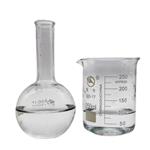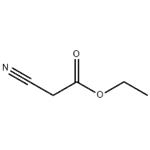- Ethyl cyanoacetate
-

- $3.00 / 200KG
-
2024-05-14
- CAS:105-56-6
- Min. Order: 1KG
- Purity: 99%
- Supply Ability: 1000mt
- Ethylcyanoacetate
-

- $100.00/ kg
-
2023-06-28
- CAS:105-56-6
- Min. Order: 1kg
- Purity: 99%
- Supply Ability: 500t/month
- Ethyl cyanoacetate
-

- $0.00 / 25KG
-
2023-04-28
- CAS:105-56-6
- Min. Order: 1KG
- Purity: 99%
- Supply Ability: 10000
|
| | Ethyl cyanoacetate Basic information |
| | Ethyl cyanoacetate Chemical Properties |
| Melting point | -22 °C (lit.) | | Boiling point | 208-210 °C (lit.) | | density | 1.063 g/mL at 25 °C (lit.) | | vapor density | 3.9 (vs air) | | vapor pressure | 1 mm Hg ( 67.8 °C) | | refractive index | n20/D 1.418(lit.) | | Fp | >230 °F | | storage temp. | Store below +30°C. | | solubility | 20g/l | | form | Liquid | | pka | 3.19±0.10(Predicted) | | color | Clear | | Water Solubility | 20 g/L (20 ºC) | | Merck | 14,3786 | | BRN | 605871 | | Dielectric constant | 26.9(20℃) | | LogP | -0.119-1.05 at 23-25℃ and pH6.1 | | Surface tension | 70.2mN/m at 1.034g/L and 23℃ | | CAS DataBase Reference | 105-56-6(CAS DataBase Reference) | | NIST Chemistry Reference | Acetic acid, cyano-, ethyl ester(105-56-6) | | EPA Substance Registry System | Ethyl cyanoacetate (105-56-6) |
| | Ethyl cyanoacetate Usage And Synthesis |
| Description | Ethyl cyanoacetate is the ethyl ester of cyanoacetic acid. Ethyl cyanoacetate hydrolizes rapidly under neutral and alkaline conditions to cyanoacetic acid and ethanol (and so it does under most physiological and environmental conditions), while in acid pH the half life is considerably longer.
Knoevenagel condensation of ethyl cyanoacetate with aldehyde is reported. Microwave enhanced Knoevenegal condensation reaction of ethyl cyanoacetate with an aldehyde, P2O5, piperidine and chlorobenzene is reported. | | Chemical Properties | Ethyl cyanoacetate is a colorless to straw colored liquid with a mild pleasant odor | | Uses | Ethyl cyanoacetate may be used in the synthesis of ethyl glyoxylate. It was used to investigate the Knoevenagel condensation reactions in microreactor using zeolite catalysts obtained by grafting amino groups onto NaX and CsNaX zeolites. | | Uses | Reagent used in labelled pyrimidine and purine synthesis. Ethyl cyanoacetate is an ester. It may be used in the synthesis of ethyl glyoxylate.It was used to investigate the Knoevenagel condensation reactions in microreactor using zeolite catalysts obtained by grafting amino groups onto NaX and CsNaX zeolites. | | Preparation | Ethyl cyanoacetate can be prepared by the action of sodium or potassium cyanide on ethyl chloroacetate, and by the action of sodium cyanide on sodium chloroacetate, followed by esterification. | | General Description | A colorless liquid. Denser than water. Contact may irritate skin, eyes and mucous membranes. Flash point 210°F. May be toxic by ingestion. Used to make other chemicals. | | Air & Water Reactions | Slightly soluble in water. | | Reactivity Profile | Ethyl cyanoacetate is both a nitrile and an ester. Esters react with acids to liberate heat along with alcohols and acids. Strong oxidizing acids may cause a vigorous reaction that is sufficiently exothermic to ignite the reaction products. Heat is also generated by the interaction of esters with caustic solutions. Flammable hydrogen is generated by mixing esters with alkali metals and hydrides. Nitriles may polymerize in the presence of metals and some metal compounds. They are incompatible with acids; mixing nitriles with strong oxidizing acids can lead to extremely violent reactions. Nitriles are generally incompatible with other oxidizing agents such as peroxides and epoxides. The combination of bases and nitriles can produce hydrogen cyanide. Nitriles are hydrolyzed in both aqueous acid and base to give carboxylic acids (or salts of carboxylic acids). These reactions generate heat. Peroxides convert nitriles to amides. Nitriles can react vigorously with reducing agents. Acetonitrile and propionitrile are soluble in water, but nitriles higher than propionitrile have low aqueous solubility. They are also insoluble in aqueous acids. | | Hazard | Toxic by ingestion and inhalation. | | Health Hazard | TOXIC; inhalation, ingestion or contact (skin, eyes) with vapors, dusts or substance may cause severe injury, burns or death. Contact with molten substance may cause severe burns to skin and eyes. Reaction with water or moist air will release toxic, corrosive or flammable gases. Reaction with water may generate much heat that will increase the concentration of fumes in the air. Fire will produce irritating, corrosive and/or toxic gases. Runoff from fire control or dilution water may be corrosive and/or toxic and cause pollution. | | Fire Hazard | Combustible material: may burn but does not ignite readily. Substance will react with water (some violently) releasing flammable, toxic or corrosive gases and runoff. When heated, vapors may form explosive mixtures with air: indoors, outdoors and sewers explosion hazards. Most vapors are heavier than air. They will spread along ground and collect in low or confined areas (sewers, basements, tanks). Vapors may travel to source of ignition and flash back. Contact with metals may evolve flammable hydrogen gas. Containers may explode when heated or if contaminated with water. | | Safety Profile | oison by ingestion.
Moderately toxic by intraperitoneal and
subcutaneous routes. Combustible when
exposed to heat or flame; can react with
oxidzing materials. Wdl react with water or
steam to produce toxic and flammable
vapors. To fight fire, use CO2, dry chemical.
When heated to decomposition or on
contact with acid or acid fumes it emits
highly toxic fumes of CN-. See also
NITRILES. | | Potential Exposure | A nitrile used to manufacture dyes,
pharmaceuticals, and other chemicals. | | First aid | If this chemical gets into the eyes, remove anycontact lenses at once and irrigate immediately for at least15 min, occasionally lifting upper and lower lids. Seek medical attention immediately. If this chemical contacts theskin, remove contaminated clothing and wash immediatelywith soap and water. Seek medical attention immediately. Ifthis chemical has been inhaled, remove from exposure,begin rescue breathing (using universal precautions, including resuscitation mask) if breathing has stopped and CPR ifheart action has stopped. Transfer promptly to a medicalfacility. When this chemical has been swallowed, get medical attention. Give large quantities of water and inducevomiting. Do not make an unconscious person vomit | | storage | re poison location. Prior to working with thischemical you should be trained on its proper handling andstorage. Store in tightly closed containers in a cool, wellventilated area away from oxidizers, strong bases, strongacids, reducing agents, moisture, and sources of ignition.Where possible, automatically pump liquid from drums orother storage containers to process containers | | Shipping | UN3276 Nitriles, liquid, toxic, n.o.s., Hazard
Class: 6.1; Labels: 6.1-Poisonous materials, Technical
Name Required, Potential Inhalation Hazard (Special
Provision 5). | | Purification Methods | Shake the ester several times with aqueous 10% Na2CO3, wash it well with water, dry with Na2SO4 and fractionally distil it. [Beilstein 2 IV 1889.] | | Incompatibilities | Incompatible with oxidizers (chlorates,
nitrates, peroxides, permanganates, perchlorates, chlorine,
bromine, fluorine, etc.); contact may cause fires or explosions. Keep away from alkaline materials, strong bases,
strong acids, oxoacids, epoxides, and reducing agents.
Nitriles may polymerize in the presence of metals and
some metal compounds. They are incompatible with acids;
mixing nitriles with strong oxidizing acids can lead to
extremely violent reactions. Nitriles are generally incompatible with other oxidizing agents such as peroxides and
epoxides. The combination of bases and nitriles can produce hydrogen cyanide. Nitriles are hydrolyzed in both
aqueous acid and base to give carboxylic acids (or salts of
carboxylic acids). These reactions generate heat. Peroxides
convert nitriles to amides. Nitriles can react vigorously
with reducing agents. Acetonitrile and propionitrile are soluble in water, but nitriles higher than propionitrile have
low aqueous solubility. They are also insoluble in aqueous
acids. Reacts with moisture, water, and steam, forming
toxic fumes. | | Waste Disposal | Consult with environmental
regulatory agencies for guidance on acceptable disposal
practices. Generators of waste containing this contaminant
(≥100 kg/mo) must conform with EPA regulations governing storage, transportation, treatment, and waste disposal. |
| | Ethyl cyanoacetate Preparation Products And Raw materials |
| Raw materials | Ethanol-->Hydrochloric acid-->Sulfuric acid-->Sodium cyanide-->Chloroacetic acid-->Ethyl chloroacetate-->Sodium chloroacetate-->Cyanoacetic acid | | Preparation Products | Ethyl 4-amino-2-(ethylthio)-5-pyrimidinecarboxylate-->2-AMINO-5-ISOPROPYL-THIOPHENE-3-CARBOXYLIC ACID ETHYL ESTER-->2-AMINO-4-ETHYL-5-METHYL-THIOPHENE-3-CARBOXYLIC ACID ETHYL ESTER-->Dacarbazine-->Triamterene-->2-AMINO-4,6-DIMETHYL-3-PYRIDINECARBOXAMIDE-->Allopurinol-->5-AMINO-4-CYANO-3-METHYL-THIOPHENE-2-CARBOXYLIC ACID ETHYL ESTER-->6-AMINO-2-MERCAPTO-PYRIMIDIN-4-OL-->3-AMINO-2,2-DIMETHYL-1-PROPANOL-->ETHYL 2-AMINO-4,5-DIMETHYLTHIOPHENE-3-CARBOXYLATE-->1-Cyclohexyl-1,2,3,4-tetrahydro-2,4-dioxopyrimidine-5-carbonitrile ,97%-->6-AMINO-3-METHYLURACIL-->2-AMINO-6-METHYL-4,5,6,7-TETRAHYDRO-BENZO[B]THIOPHENE-3-CARBOXYLIC ACID ETHYL ESTER-->1,2,3,5-TETRAHYDRO-8-THIA-5,7-DIAZA-CYCLOPENTA[A]INDENE-4-ONE-->5,6-Diamino-1-methyluracil-->6-AMINO-2-METHYLTHIO-3-METHYLURACIL-->5-CYANO-6-HYDROXY-4-METHOXYMETHYL-2-METHYLPYRIDINE-->GUANINE SULFATE-->6-AMINO-1-METHYL-5-NITROSOURACIL-->6-CHLORO-5-CYANO-4-METHOXYMETHYL-3-NITRO-2-PICOLINE-->Ethyl α-cyanoacrylate instantaneous adhesive-->2-CHLORO-4-METHYLQUINOLINE-3-CARBONITRILE-->ETHYL 2-AMINO-4,5,6,7-TETRAHYDROBENZO[B]THIOPHENE-3-CARBOXYLATE-->6-Amino-1-methyluracil-->2-Amino-4-trifluoromethylbenzonitrile-->ETHYL 5-AMINO-1-PYRIDIN-2-YL-1H-PYRAZOLE-4-CARBOXYLATE-->2-AMINO-5,6-DIHYDRO-4H-CYCLOPENTA[B]THIOPHENE-3-CARBOXYLIC ACID ETHYL ESTER-->2-(4,6-diamino-1,3,5-triazin-2-yl)acetic acid-->5-AMINO-3-METHYL-1H-PYRAZOLE-4-CARBOXYLIC ACID ETHYL ESTER-->1-ETHYL-1-METHYLSUCCINIC ACID-->6-Aminouracil-->Disperse Yellow S-3GL-->Amiloride hydrochloride-->ETHYL 2-CYANO-3-METHYL-2-PENTENOATE-->ETHYL(Z)-2-CYANO-3-ETHOXY-2-PROPENOATE-->4-Amino-6-hydroxy-2-mercaptopyrimidine monohydrate |
|